

The Guardian, 31 marzo e 31 ottobre 2017. Mentre si sta completando un grande progetto di rinnovamento di spazi pubblici, avanza la demolizione in massa di case economiche che sfratterà circa un milione di abitanti. (i.b)
Il centro della città di Mosca si sta rinnovando attraverso un grande progetto di riqualificazione urbana denominato “Moja Ulitsa” che significa “La mia via”. Lanciato nel 2014 dall’amministrazione comunale sta completando la realizzazione di 50 nuovi parchi, la risistemazione di 50 km di strade e piazza, 12 lungofiumi, e il restauro di moltissime facciate storiche, con progetti del Design Strelka e alcune star dell’architettura mondiale.
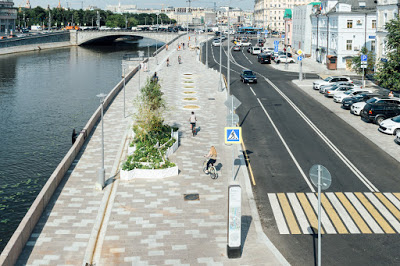 |
| Uno dei lungofiumi riqualificati dal programma "La mia via" Fonte: Russia Beyond |
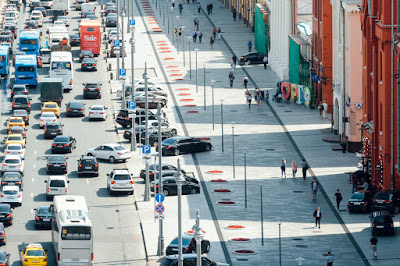 |
| Una delle strade rinnovate dal programma "La mia via" Fonte: Russia Beyond |
 |
| In primo piano i "khrushchevka" da essere demoliti, sullo sfondo i nuovi edifici Fonte: The Guardian |
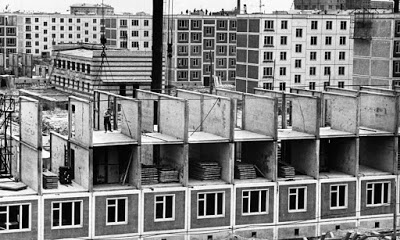 |
| Il sistema prefabbricato di un edifico costruito nel 1961. Fonte: The Guardian (Getty Images) |
All’approvazione della demolizione i residenti hanno 90 giorni di tempo per evacuare e trovarsi un altro alloggio. Sono circa un milione le persone coinvolte nel programma di demolizione dei palazzi sparsi in diverse zone della città.
Con il sostegno del presidente Vladimir Putin, il sindaco di Mosca Sergei Sobyanin ha dichiarato il programma una "necessità assoluta" per poter sostituire le vecchie abitazioni. Mentre per molti abitanti questa è un operazione di pura speculazione, in cui i soldi hanno il sopravvento su qualsiasi altra cosa. I residenti sostengono che, pur non essendo perfetti e avendo bisogno di essere ristrutturati, sono solidi. Inoltre non solo rappresentano un pezzo di storia ma danno un senso di appartenenza a comunità di quartier consolidate nel tempo. Non vogliono trasferirsi in nuovi grattacieli costruiti in zone a loro estranee. Perchè nonostante le promesse dell’amministrazione sarà difficile che gli abitanti potranno rimanere in zona.
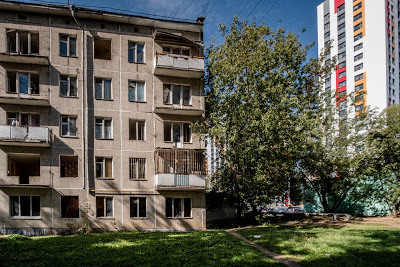 |
| Uno dei "khrushchevka" in procinto di essere demolito Fonre: The Guardian |
Gli articoli del Guardian, qui sotto ripresi, documentano questo processo.
La seconda operazione riguarda la completa riqualificazione dei cortili residenziali. L'ufficio del sindaco sostiene che questi spazi, situati all’interno di grandi complessi, non dovrebbero essere dei passaggi pubblici aperti di collegamento, ma devono diventare degli spazi privati.
L’amministrazione è in procinto di adottare entro la fine dell’anno nuove norme regionali di pianificazione urbana che dividono per la prima volta i quartieri residenziali in aree private e pubbliche. Gli accessi al piano terra ai negozi e attività aperte al pubblico avverrà solo dalla strada per consentire che le corti di diventare degli spazi di “comfort” con accesso riservato e solo pedonale. Qui il link a un articolo del Russian Reader . (i.b.)
MOSCOW'S BIG MOVE: IS THIS THE BIGGEST URBAN DEMOLITION PROJECT EVER?
di Alec Luhn
Finally his turn came, and he and his wife were given a two-room flat at 16 Grimau Street. Built in 1957, the four-storey, 64-flat building is considered the first “Khrushchevka”, a kind of prefabricated, low-rise flat block that was erected in the tens of thousands across the USSR and came to be called after then-Soviet leader Nikita Khrushchev (The colloquial term has come to apply to almost any late Soviet five-storey residential building.)
Now 16 Grimau Street, along with up to 7,900 other Soviet flat blocks in Moscow, are to be torn down, in what will be one of the largest urban resettlement programmes in history. With the backing of the president, Vladimir Putin, Moscow mayor Sergei Sobyanin has declared the programme an “absolute necessity” to replace ageing housing. He promised the replacement flats would be 20% larger on average.
To Rudakov, however, it is just another example of profit taking precedent over heritage. “This is the first housing block that Khrushchev built. They don’t have any regard for this now,” he said of his home. “Money comes before anything else.” He added that he didn’t “know why Putin said” to tear such flat blocks down. “The building is good, the walls are thick.”
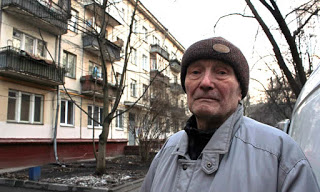 |
| Yevgeny Rudakov, che vive in quello che è considerato il primo "krushchevka", costruito nel 1957. Fonte: Alec Luhn /The Guardian |
Furthermore, the federal legislation to give the Moscow city government power to knock down entire neighbourhoods has worrying implications for the rights of residents and small-business owners. Residents who do not sign an agreement to transfer ownership of their flat within two months will be taken to court. “They are forcing people out, like under Stalin,” said activist Lena Bogushch.
Opposition activist and former MP Dmitry Gudkov noted that the legislation would allow the government to tear down not just Soviet prefabricated flat blocks, but also nearby “analogous” buildings. When asked about how the fate of nearby buildings would be decided, the author of the law, MP Mikhail Degtyaryov, recently told TV Rain that a city commission would simply “take a neighbourhood and circle” the whole thing for demolition.
“The law allows the programme to be realised not in the interests of residents, but in the interests of the construction lobby,” Gudkov said.
Since Sobyanin came to power in 2010, Moscow has tackled several huge urban development projects. It has refurbished Gorky Park, opened the Moscow Ring Railroad, and started a 120bn-rouble (£1.4bn) renovation of one million sq metres of streets. It has encouraged the demolition and redevelopment of gigantic Soviet industrial areas.
But the programme to renovate five-storey buildings, as the city euphemistically calls it, will be by far the largest undertaking yet. Although the city has yet to list the buildings that will be demolished, Sobyanin has promised that 25 million sq metres of residential real estate – more than 10% of the city’s housing stock – will be torn down. An estimated 1.6 million people will be resettled. The city says it will spend at least 300bn roubles, and independent experts have estimated the actual investment will be 3tn roubles.
It’s not clear what kind of buildings will replace the Soviet housing. Moscow’s chief architect declined to comment, and the mayor’s office asked for written questions but failed to answer them.
 |
| Il Soviet costruì circa 200 milioni di metri quadrati di appartamenti tra il 1933 e il 1970. Fonte: The Guardian (skyNext/Getty Images/iStockphoto) |
Thus began a three-decade housing drive that was unprecedented in human history. It ushered in a new, industrial approach to construction: several different designs for prefabricated flat blocks were tried out in the Cheryomushki neighbourhood, where Rudakov lives, as was a residential district layout – minimising through-traffic and maximising green space – that would be repeated throughout the country.
Working mostly with concrete panels and other factory-produced components, brigades of labourers competed to see who could put together the huge flat blocks the fastest. One team managed it in 11 days. According to the Russian state statistics service, the amount of housing built by the state jumped from 26.9 million sq metres during the second five-year plan (1933-37), to 152.2 million sq metres in 1956-60 and 227.6 million sq metres in 1966-1970. Between 1955 and 1964, a quarter of the Soviet population, or 54 million people, received their own flats. By 1975, the state had built 1.3bn sq metres of housing, and it continued to build in huge amounts up until the Soviet breakup.
For the first time, large numbers of people had private housing in the city. This huge resettlement marked a boost in quality of life, a change in living habits, and a cultural shift that was commemorated in works including Dmitry Shostakovich’s operetta Cheryomushki, named after the neighbourhood where the first Khrushchev flats were built. “Look the hallway is ours, look the coat rack is ours! The whole flat is ours, ours! The kitchen too is ours, ours!” sang the main characters in a 1962 film based on the operetta.
According to Olga Kazakova, an art history PhD student and director of the Institute of Modernism, one theory is that along with Khrushchev’s de-Stalinisation policies, the privacy allowed by Khrushchevka flats contributed to the rise of dissident activity, such as samizdat (the copying and passing of banned literature by hand), in the 1960s.
In addition, the new housing was fairly low-density, and its common areas and green space facilitated socialising among neighbours, according to Nikolai Yerofeyev, a philosophy student at Oxford who is writing his dissertation on postwar Soviet housing. He also owns a flat in a Khrushchevka that will probably be torn down.
Of course, such mass-produced housing had drawbacks. The height of functionalism, Khrushchevka were architecturally monotonous: rectangular, five-storey boxes with evenly spaced windows, balconies and staircases. The ceilings were low and single-room flats were typically only 30-33 sq metres, while two rooms were 33-45 sq metres. Lifts and trash chutes were shunned as a costly extravagance. There were complaints about sound isolation and heating in the wintertime. Some included strange innovations, such as a small niche beneath the kitchen window, separated from the outside by only a few centimetres, meant to function as a refrigerator in the cold months.
The five-storey buildings were designed to last about 25 years. Most have served longer, with mixed results. Retired dentist Sofa Shkolnik, who lives with her husband, Felix, in a five-storey flat block built in 1962, said she is warm in the winter and can barely hear the neighbours. The building, which is surrounded by green space with apple, cherry and pear trees and several playgrounds, is on a tentative list of blocks to be torn down. Shkolnik fears they will be resettled to a high-rise building or moved far away from their daughter, granddaughter and great granddaughter, who all live nearby (the city has promised to resettle residents within their districts, but some of these cover large, incongruous areas).
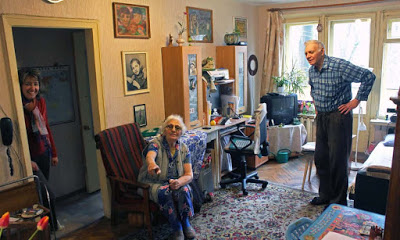 |
| La famiglia Shkolnik nel loro soggiorno Fonte: The Guardian (Alec Luhn) |
But Felix said the sewage drainage system had not been replaced and had burst a pipe twice in the past decade. “We’re on a state of alert in case it breaks in another place, because the utilities are old,” he said, adding that he had recently drilled into the concrete panel wall to find it was disintegrating.
Sobyanin argued that the five-storey buildings are too difficult to renovate, since the pipes for plumbing and central steam heating are built into the wall. “Even if we do some sort of renovations in these buildings, in 10 to 20 years they will nonetheless turn into hazardous housing,” he told Komsomolskaya Pravda newspaper.
The quality and condition of five-storey buildings varies widely. While many were built with concrete, others were built with bricks, which are typically sturdier and more heat-efficient. The most dilapidated Khrushchevka buildings in Moscow have already been torn down, according to Yerofeyev. He called the programme an attack on “low population density, [which] apparently is too big a luxury in Moscow now”.
“The argument that they are in bad condition structurally is not convincing, especially since there are massive projects to reconstruct Khrushchyovka buildings in eastern Europe,” he said. “There are many methods of how to deal with (ageing prefabricated housing), and of course tearing it down and building a new tower is not the best one.”
n one notable example, Stefan Forster architects in Leinefelde, Germany, knocked down the top floors of eight Soviet flat blocks from the 1970s, stripped them down to their concrete structure and outfitted them with new windows and balconies and ground-floor gardens as part of an urban regeneration project.
Forster said renovation costs depend largely on how much is rebuilt to modern construction standards, such as better sound isolation requirements. “In principle, prefab flat blocks are suitable for conversion to affordable housing,” he said.
But Moscow is reportedly not up to the difficulty and cost of such a task. Earlier this month, the respected business newspaper Vedomosti quoted an unnamed official as saying the city had decided that building new housing would be cheaper than renovating. According to official statistics, half of the residential buildings in Moscow are in need of major structural repairs, and only a few dozen have been redone.
Another reason may be political, as Sobyanin and Putin are both likely to run for reelection in 2018. Political analyst Dmitry Orlov estimated that as long as residents aren’t moved too far away and small business owners are fairly compensated, the new programme could boost electoral support in Moscow by 15% for the mayor and 7% for the president. He based this on how a smaller resettlement programme under previous mayor Yury Luzhkov had “changed public opinion (and) allowed him to preserve a high level of trust over the years”, he said.
Activists’ main complaint is that the programme is mostly about money, and both developers and the city stand to make a handy profit. They point to a recent example of a partially completed programme started in 1999 to replace 1,722 five-storey buildings. For that scheme, the city contracted private developers, who built new tower blocks, set aside 30% of the apartments to resettle residents of the old buildings, and sold the rest. Vedomosti quoted a source in the mayor’s office as saying the new programme will free up a large number of land plots that will be sold to investors at auction.
The devil will be in the detail, and specifically in what kind of housing is built and where; new residential towers in Moscow are often as tall as 25 storeys, leading to less personable neighbourhoods and more traffic congestion. Already, Moscow traffic jams are among the worst in the world. Housing density will almost certainly increase, given that that five-storey buildings now occupy 8,000-10,000 sq metres per hectare, while city norms allow for up to 25,000 sq metres per hectare.
“They haven’t told us what technologies will be used in the new buildings, how they will look, and the quality of modern construction in Russia is not that high,” Kazakova said.
According to Maxim Trudolyubov, editor-at-large of Vedomosti, the programme’s results will depend largely on whether private firms or a state construction company build the new housing. “Private companies will need to sharply increase the amount of square metres that exist in Moscow, “which will choke the city for good with torrents of people and transport,” he wrote in a recent column.
For now, residents face an uncertain future. “Where will they put the people?” asked the Shkolniks’ daughter, Anna. “That makes us uneasy.”
31 ottobre 2017
THE WRECKING BALL SWINGS AT MOSCOW
A PHOTO ESSAY
di Chris Leslie and Jonathan Charley
In June this year, the Moscow Duma unanimously approved the demolition of more than 4,000 apartment blocks in various sites across the sprawling city, home to nearly 2 million people. Most of this housing is privately owned, the consequence of the privatisation of state housing after the collapse of the Soviet Union. It has been a highly controversial decision, bringing thousands of Muscovites into the streets in protest.
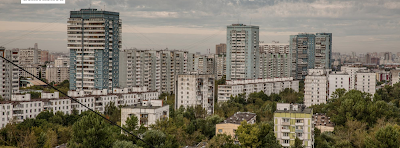 |
| Al centro la serie di edifici "khrushchev" nel quartiere Butirsky che saranno demoliti Fonte: The Guardian |
The prototype
The Fedosovas’ estate is well-connected to the city centre. Essential services – kindergarten, schools, a health centre, transport links – are easily accessible on foot, and their flat looks down on to apple trees, flowers and a children’s play park. It is tranquil, the air is fresh and the development is planned at a human scale. Both Fedosova and her father grew up there; several generations of her family live in nearby flats.
Under the June law, if two-thirds of residents in a block vote yes to the so-called “renovation programme”, the block will be demolished. Fedosova voted no: for her, the demolitions won’t just destroy buildings, but also a sense of history, home and belonging.
Enough yes votes were cast, however, to slate the building for demolition. Once she receives the official notice, Fedosova will be required to leave her home in 90 days, or face forced eviction. She will be given no option of where to live, likely moved to a newly built tower block. The authorities have promised that residents will be rehoused in the same district, but many fear their longstanding networks of families and friends won’t survive the move. Above all, Fedosova fears being exiled in “New Moscow”, the hastily erected towers on the city’s periphery, many of which remain unsold. .
“The attitude towards people is bestial,” she says. “How is it possible to take people and move them to where the authorities want, in high-rise pens with just a patch of greenery in the middle? You cannot treat Moscow and its inhabitants like this. We are not here for the short-term. The city should be built for the comfort of its residents and not developed for the sake of maximising profits at all costs. I’m afraid of the new areas, they are creepy.”
The fix
To counteract the rumours that the renovation programme is really all about profiting from real estate the mayor of Moscow, Sergey Sobyanin, is working overtime to persuade residents that there is no alternative to demolition. His team are busily constructing show flats kitted out with state-of-the-art furnishings. Sobyanin insists that the Khrushchevka flats are beyond redemption: the kitchens are too small, there are no lifts or waste disposal system and the roofs often leak.
Yet many residents maintain nothing is wrong with their flats that standard repairs couldn’t fix. Anastasia Yanchikova is one of numerous residents left exasperated and confused by these explanations.
“I feel safe here. I can see my children in the yard,” she says. “We leave our bikes at the bottom the stairs. I have a right to stay in my neighbourhood. I want to choose myself where to live, in what kind of building, place and so on.
“I feel deceived. Two years ago politicians obliged me to pay into a capital repair fund for the overhaul of our housing that was scheduled to be completed by 2030. They told us that the houses are strong. And then this year the same politicians tell us that our homes are in an emergency condition and need to be demolished?”
Tatjana Goreleva, a lawyer, and her husband say they have invested more than 1m rubles in their apartment, in a five-storey block of robust brick in the Nishegorodsky district. Like Yanchikova’s, her house was also scheduled for major repairs in 2016 that were never carried out. Her anger mixes with suspicion.
“It is as if this has been done deliberately to bring the house into an emergency condition, and to finish off the opponents of demolition and renovation – morally and physically.”
There are undoubtedly problems with some of the older flats; the build quality is variable. Some architects and engineers argue, however, that the faults can be remedied without prohibitive expense. Professors at the prestigious Moscow Academy of Architecture such as Yuri Pavlovich Volchok and architect Evgeny Asse have said that with intelligent design many of the blocks can be given a new lease of life; structural engineer Sofia Pechorskaya notes that the planning process, which she calls “technically illiterate”, has been carried out without proper research and professional consultation.
Vladimir Komarov, a retired government worker, lives in a veritable theatre set of Russian history. His flat is lined with antique green wallpaper, the floors are original hardwood, and he is surrounded by family portraits and clocks made by his horologist grandfather. Three generations have lived here; his grandmother is buried in the cemetery next door. When he received his eviction notice, Komarov had a stroke that put him in hospital for two months. He says he has been loyal to the state all his life, and feels betrayed.
His friend, Vera Voronina, boasts a brand new bathroom, kitchen and living room in her apartment. Over a six-year period, she and her husband saved everything they could and renovated the flat themselves. Though it is nearly complete, the majority of residents in her block voted for demolition, so they will be thrown out.
The residents of their building say their neighbourhood has its own special ecology: it boasts a district heating system and is well served by hospitals, clinics, schools, shops and transport links. Speculation swirls that this is why their apartments face the wrecking ball while other blocks that, they say, are more clearly in need of repairs but more isolated, are left standing.
One option for homeowners is monetary compensation based on what the authorities reckon the flat is worth. But many residents doubt they will receive a fair price. “Since May of this year we have lived as if on top of a powder keg,” says Goreleva. “We do not agree with the renovation program, but to challenge the new laws is not an easy thing to do,” Goreleva adds. “We are law-abiding citizens, and if the state has established the rules on renovation, we are compelled to obey them. But in respect of our home, there has been a clear violation of laws and regulations.”
One of the consequences of the privatisation of the Russian housing sector was that homeowners became responsible for the upkeep and maintenance of their properties. For many people on low incomes who couldn’t afford to invest in repairs and renovations, this became an impossible burden. Vast numbers have voted for demolition having been lured by the prospect of a new apartment. Not surprisingly, the vote has caused considerable friction between friends and neighbours on opposing sides of the debate.
Olga and Vassily Leskova met at school. They have lived in their beautifully appointed apartment for 50 years, and seen their children and grandchildren grow up here. They are distraught at the news of their eviction.. Vassily sums it up in one phrase: “Pure deception.”
For the Leskovas, the vote has meant the breakup of the social foundations on which people have built their lives. The peace and harmony of their block has disintegrated. Arguments and shouting matches have broken out. The atmosphere has become hostile. The required meeting of all the residents to decide on the fate of their block never happened; instead, people voted individually and in secret.
One person who has seen both sides of the story is Tatyana Buyanova, an architect and town planner who lives a 10-minute walk away from the Leskovas with her son. Her picturesque two-storey cottage sits on prime land. A former employee of one of the development companies, Buyanova was involved in the selection of potential sites for new housing in the earmarked “renovation zones”.
Buyanova began to suspect that the urban restructuring programme was more about real estate speculation than any social commitment to improving people’s lives. Some journalists, lawyers and engineers say that building codes – including for light, height and proximity of buildings – are being relaxed, and construction permits expedited. When her own home – which she maintains was in good condition – was included on the demolition list Buyanova resigned and joined the protest movement.
“I can not understand how something that in principle is a good idea turned into a horror and a nightmare,” she says. “My neighbours voted for the demolition. I was against it, but it didn’t change anything. The city will not talk to me. One of the deputies even said, ‘Dissenters must submit!’ My apartment is everything that I hold dear – and now I’m losing it.”
Pavel Novikov, an engineer, lives in the former industrial district of Metrogorodok. His flat is not included in the programme, which he suspects is because the building site is too narrow to be of interest to developers. The blocks either side are coming down.
A member of the Muscovites Against Demolition protest group, he is typical of the activists who are resisting the demolitions. Most are ordinary folk: pensioners, single parents, newcomers to political action. Notably, a majority are women.
“One of the strange things about the protest movement,” Novikov says, “is that it has awakened in Muscovites a sense of having civil rights, and of their ability to oppose the state’s interference into their private lives.”
Certainly the sense of illegal dispossession is palpable, and in the early days of the protests banners were emblazoned with the word “deportation”. Nikolai Kanchov, who ran in the recent municipal elections for the Yabloko opposition party, argues that the forced evictions violate the Russian constitution, which guarantees the right to private property.
“In a nutshell, the demolition program has deprived me of my right to a home,” he says. “It has made me worried and uncertain about the future. I can’t be sure that my family and I won’t be forced out of our home tomorrow by the will of some tricky bureaucrat, greedy for money. I’m forced to study the legislation and collect testimony, write petitions, claims and appeals, gather signatures, all in order to protect my home. Instead of working and earning my living.”
As well as standing for local government, lobbying deputies, and holding street demonstrations and social media campaigns, dissidence has taken other forms. Artem Loskutov and Lucia Stein came to the attention of residents who noticed a new addition to the graffiti in the Basmanny district: plaster casts of a woman’s breasts, glued to five apartment blocks scheduled for demolition, accompanied by the slogan: “I will protect your home with my breasts.”
It made Stein a minor celebrity, and at just 21 years old she has just been elected as an independent deputy for the Moscow municipal government.
The demolition
Photographer Vivian del Rio can stare down, from her current flat, on the partially demolished neighbourhood where she once lived. She still remembers the chaos of moving out: people were still packing their bags as the wrecking crews moved in. Reluctantly, she has accepted a new flat in multi-storey tower.
“The view from up here is good, but I miss the birds and fruit trees, the high ceilings, and the neighbourliness. Also, this flat is poorly built. They wallpapered over cracks in the concrete. The doors were replaced within two months and they cheated me by including my balcony in the overall area of the flat.”
 |
| Anche il cottage di Tatiana Buyanova sarà demolito Fonte: The Guardian |
A kilometre down the road house lies a neighbourhood that will be completely razed. According to the Moscow Development Department’s interactive map, which shows all the properties scheduled for demolition, 80 apartment blocks will be removed in just this one locale. The website also shows the locations of the new replacement tower blocks – and the large area of land that will then become available for sale. Tellingly, it is close to the city centre, and only two stops from fashionable Gorky Park and the Tretyakov gallery. The land will be sold into the private sector; several luxury towers featuring penthouse flats have been built; there is speculation that other plots may be handed directly to banks by struggling construction companies to repay loans.
After the 90-day eviction period, the timing of the demolition itself is not made public, but the process can be rapid: whole blocks have disappeared in a day. In the Butirsky district of north Moscow, you can see the rubble of recently demolished five-storey buildings. From the top floor of one partially evacuated block, an old lady looked out with a smile. The flats either side of hers are already empty, but she doesn’t look in any hurry to move.
In Krilatskoye, in the north-west of the city, furniture is flying out of the frameless windows. In the empty flats, children’s drawings hang from the wallpaper and family photographs lie on the floor. Clothes, shoes and a ceramic print of someone’s grandmother sit in a pile. People have left in a hurry.
On the third floor of what otherwise appeared to be an entirely deserted block, one padded front door remains locked. The inhabitants have pinned a sign to it:
“We live in this apartment. If you don’t understand, take a look at article 139 of the Russian constitution: ‘The violation of the inviolability of the home.”
Chris Leslie is a documentary photographer and film-maker. Dr Jonathan Charley is a writer and teacher at the department of architecture of the University of Strathclyde. You can read more about their Disappearing Moscow project here.